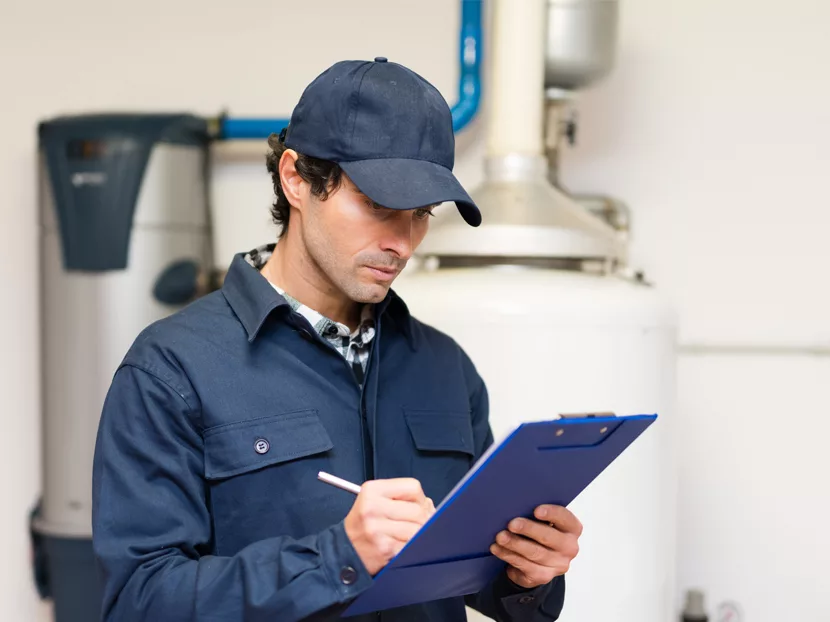Last month, we talked about how to properly size a boiler. It’s great information to have, and it gives you a significant edge on most heating contractors. Many don’t bother, but if you want to maximize efficiency, minimize short-cycling heat loss through the boiler jacket and up the stack, and avoid the wear and tear caused by the thousands of unnecessary ignition attempts — it’s one of the best practices you can do to ensure a long and efficient boiler life.
Now what?
Well, we choose a boiler that’s able to meet the heat loss of the building on the coldest day of the year, based on the heat loss load calculation we just finished. Sounds easy, but if you’re not sure of the terms or the number of manufacturer terms that mean the same thing, you’re heading for a world of hurt.
Let me know if any of these terms sound familiar: MBH, input MBH, output MBH, heating capacity MBH, IBR rating, AGA rating, AHRI rating, DOE heating capacity, thermal efficiency, combustion efficiency, AFUE, piping losses and pick-up losses.
No matter which boiler manufacturer’s Data and Specifications Sheet you’re looking at, you’re going to see those terms. It’s essential to know what they mean — and which ones mean the same thing. It would be nice if everyone agreed on one term for each piece of specified data listed.
In front of me are specification sheets from Burnham, HB Smith, Viessmann, Weil-McLain, Lochinvar, Peerless and others. The only universal term is input MBH and the various efficiencies. My intention is to give you a cheat sheet to be referenced when confusion sets in.
But first, I’d like to tell you how I was taught to do it back in the ’80s. It was wrong, very wrong. It’s a short story because it’s about short cuts and rules of thumbs, which are OK sometimes, but not for sizing modern-day, high-efficiency equipment.
Remember, the lion’s share of my career was spent in Chicago. In fact, it’s only been four months since I left. Here it is: 600 BTU/hr./square feet/ton for air conditioning and 50 BTU/hr./square foot for heating. Yes, you read that right — 50 BTU/hr./square foot for heating! I’m not a big fan of exclamation points, but if ever a sentence deserved one, it was that one.
For hot water heating systems, I was told to measure the connected equivalence of direct radiation and size the boiler accordingly to the EDR on the manufacturer’s technical datasheet. I must admit, I did it for a while. I had little experience and they’d been around forever.
But I have an annoying habit of questioning most things, and it’s only annoying if I vocalize the question. It usually starts with a look of disbelief, followed by a mental note to investigate what I’m being told. It had been a few years since I graduated trade school and now I was being taught these CYA rules of the thumb. I knew this is wasn’t what my teacher taught me in school.
That’s when proper design started happening for me. After work and on weekends, I’d be digging through old textbooks and other literature I’d been collecting. The Internet wasn’t a thing then, so Googling was not an option. Here’s what I know today.
Back in the day, The Institute of Boiler and Radiator Manufacturers put their collective heads together and gathered results from testing hydronic systems and components. They did it in the laboratory and a six-room residence they built at the University of Illinois. Lots of good things and people come from that state. You can almost see me smiling, can’t you?
That endeavor eventually morphed into The Hydronics Institute and is now a division of the Gas Appliance Manufacturers Association. About 12 years ago, they became part of the Air Conditioning, Heating and Refrigeration Institute. The history of these institutes goes back 100 years; it’s well worth looking into. If you have been in the industry a while, you’re almost certain to have seen these names on boiler data plates or in manufacturer’s data.
Boiler terms, defined
As you can see, the AGA is involved and the Department of Energy is certainly involved. In fact, on today’s equipment AHRI certificates, it plainly states:
“Rated as follows in accordance with the Department of Energy Boiler test procedures as published in the latest edition of the Code of Regulations, 10 CFR Part 431 and subject to verification of rating accuracy by AHRI-sponsored, independent third-party testing.”
For me, that’s it in a nutshell. But these are the terms you’re still likely to see and need to know.
• Input MBH: Simple enough; it’s the firing rate of your boiler.
• Gross output MBH = Heating capacity MBH = DOE capacity MBH: The thing about these three is they all mean the same thing. Almost. They can be defined as the rate at which the boiler transfers heat to the system water, assuming the heat loss through the jacket is wasted.
For boilers with an input MBH less than 300, you multiply the input MBH by the listed AFUE rating. A Peerless 63-03 with an input MBH of 118 and AFUE of 83.5 percent has a gross output of 99 MBH.
118 x 0.835 = 98.53 MBH, rounded up to 99 MBH
Here’s where the “almost” comes in to play. For boilers with an MBH of 300 or more, you multiply the input MBH by the listed thermal efficiency.
• Net rating MBH = Net AHRI rating MBH = Net IBR rating MBH: Same for these three; they all share the exact definition. It’s obtained by multiplying the gross output by 0.85. This equation assumes that 15 percent of a boiler’s gross output is lost through the piping before reaching the heat emitters.
The common name for this assumption is the pick-up allowance. Of course, any degree of pipe insulation is going to alter that assumption or negate it altogether.
• AFUE: This acronym, also known as Annual Fuel Utilization Efficiency, applies only to boilers under 300 input MBH. This seasonal test procedure was developed by the U.S. Department of Energy and ensures compliance with an act of Congress. Really.
It takes into account cycle losses and standby losses and is averaged over the course of the heating season. Lots of assumptions go into this value as well, so investigate at your own peril.
• Combustion efficiency: This value is calculated by the flue gas temperature and the flue gas's carbon dioxide content while firing under steady-state conditions, usually via a combustion analyzer. It is defined by the burner’s ability to convert fuel to heat energy, based on a theoretic heat value that’s always changing.
Some companies use this measurement to predict annual fuel usage. Don’t do that. You can’t because it’s measured under continuous firing conditions, which is entirely unrealistic. Your numbers and projected savings are going to be woefully wrong.
• Thermal efficiency: This is like the commercial equivalent of AFUE. It only applies to boilers with 300 input MBH and greater. It considers the rate at which the boiler’s heat exchanger transfers heat to the water, minus jacket losses. Another way to define it is a fuel-to-water efficiency.
Using gross output
Back to choosing a boiler. Typically, I would make my selection using the gross output; I base it on two things. The first is that in my experience, there’s a fudge factor built into any load calculation I’ve ever done. You can verify this if you don’t believe me. When your area's winter temperatures are at the very coldest, I mean brutally cold, check to see if your boiler or furnace is running continuously. Or is it cycling on and off; if it is, how often?
If it’s running continuously or near continuously and maintaining temperature near 70 F, chances are your equipment is sized correctly. I say chances are because I’m assuming the appliance doesn’t have a service-related issue that could have a bearing on this experiment.
The second is that it makes complete sense to invest in pipe insulation. The investment will pay for itself very quickly, and you’ll be delivering the heat to where it belongs: the heat emitters.
I know so many contractors who don’t take the time to do a heat loss load calculation and ballpark the boiler size based on the one already there because they think it’s too time-consuming or too risky. It’s neither. I can attest to that.
And then there are those who take the time and effort to do a heat loss load calculation only to select a boiler with a far-greater capacity just to be safe. Ughh.
I would love to see you perform the load calculation and select a boiler based on it; use the net MBH if it’s more in your comfort zone. If you’re not sure, reach out and ask questions of people who do know. There’s no shame in that. You can’t get answers without questions. I’m confident once you do it the right way that first time, you’ll never go back to guessing.





